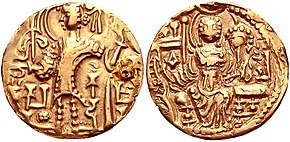Gupta–Kidarite Conflict
| Gupta - Kidarite Conflict | |||||||
|---|---|---|---|---|---|---|---|
| Part of Gupta–Hunnic Wars | |||||||
 Kidarite Kingdom | |||||||
| |||||||
| Belligerents | |||||||
| Gupta Empire |
Hephthalites *Kidarites | ||||||
| Commanders and leaders | |||||||
| Skandagupta | Varhran I of Kidarites | ||||||
The Gupta - Kidarite Conflict was a military confrontation of the Imperial Guptas Under the Command of Skandagupta during the Reign of Kumaragupta and the Kidarites.
Background[edit]



 Ku-shā-ṇa) Kidara (
Ku-shā-ṇa) Kidara (

 Ki-da-ra) Kushana (
Ki-da-ra) Kushana (

 Ku-shā-ṇa). Enthroned goddess Ardoxsho on the back.
Ku-shā-ṇa). Enthroned goddess Ardoxsho on the back.The Kidarites consolidated their power in Northern Afghanistan before conquering Peshawar and parts of northwest India including Gandhara probably sometime between 390 and 410,[3] around the end of the rule of Gupta Emperor Chandragupta II or beginning of the rule of Kumaragupta I.[4] It is probably the rise of the Hephthalites and the defeats against the Sasanians which pushed the Kidarites into northern India , this proved to be a threat to the Guptas.
The Conflict[edit]
...whose [Skandagupta's] fame, moreover, even [his] enemies, in the countries of the mlechchhas... having their pride broken down to the very root, announce with the words "verily the victory has been achieved by him."
— Junagadh inscription[5]
It is more likely that the enemies who threatened the sovereignty of the Guptas were not only the Pushyamitras, but also the Kidarites. In the Junagadh inscription, it refers the Kidarites (or the Hephthalites; who are referred to under the name of the Mlecchas. Skandagupta's victories over the mlecchas were described as the conquest 'of the whole world'. It is hard to figure what this claim refers in terms of geographical fact, but it appears that Skandagupta's armies repulsed the Kidarite invasion somewhere on the River Sutlej (or perhaps further east). Thus, even after Skandagupta's victories, central and western Punjab probably remained in the hands of the invaders, although he had managed to stop their advance eastwards.[6]
References[edit]
- ^ Śrivastava, Vijai Shankar (1981). Cultural Contours of India. Abhinav Publications. ISBN 978-0-391-02358-1.
- ^ Dani, Ahmad Hasan (1999). History of Civilizations of Central Asia. Motilal Banarsidass Publ. ISBN 978-81-208-1540-7.
- ^ Dani, Ahmad Hasan; Litvinsky, B. A. (1996). History of Civilizations of Central Asia: The crossroads of civilizations, A.D. 250 to 750. UNESCO. p. 122. ISBN 9789231032110.
- ^ "The entry of the Kidarites into India may firmly be placed some time round about the end of rule of Candragupta II or beginning of the rule of Kumaragupta I (circa 410-420 a.d.)" in Gupta, Parmeshwari Lal; Kulashreshtha, Sarojini (1994). Kuṣāṇa Coins and History. D.K. Printworld. p. 122. ISBN 9788124600177.
- ^ R. C. Majumdar 1981, p. 73.
- ^ A Comprehensive History of India: pt. 1. A.D. 300-985. 1981.
Sources[edit]
- R. C. Majumdar (1981). A Comprehensive History of India. Vol. 3, Part I: A.D. 300–985. Indian History Congress / People's Publishing House. OCLC 34008529.
